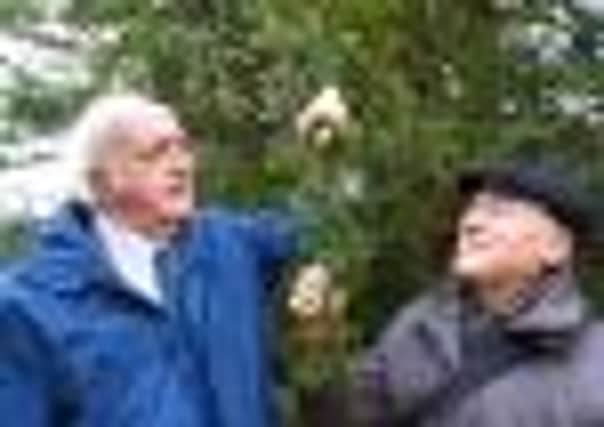Ten years to root out full story of plant life


It is a freezing cold winter’s day and not the most appropriate time to be talking about wildflowers. In this area of woods and parkland on the outskirts of Sheffield, just about the only splashes of colour are provided by the berries on holly bushes and some old yew trees.
But two of the three editors of the new South Yorkshire Plant Atlas, a 460-page tome, are excited about a winter-related find. It has been made by the team of almost 100 botanists who supplied records of every plant in the county, from the tiniest weed to an ancient sessile oak with a tree trunk almost 25 feet in girth.
Advertisement
Hide AdAdvertisement
Hide Ad“Look at this,” says Geoffrey Wilmore, who is one of Britain’s top botanists. He turns up one of the atlas’s maps peppered somewhat unevenly with black dots denoting the presence of particular plants within one-kilometre squares.
“See how the black dots on this map actually form straight lines,” he points. “Now, nature doesn’t often conform to such clean lines, so how did this species of plant end up growing in an absolute straight line on the map?”
The reason, he says, is that the plant in question is Danish Scurvy-grass, something which is usually found on the coast. Yet it is thriving deep inside land-locked South Yorkshire because of the salt that is spread on roads each winter. The straight lines are major roads where it grows profusely in grass verges.
The minute seed was probably blown 40 miles from the North Sea coast, or carried on the beaks of birds. And for a two-week period in April it covers the roadside verges with its lovely pale lilac flowers.
Advertisement
Hide AdAdvertisement
Hide AdThe atlas is the culmination of ten years of research and recording by local botanists and natural history societies.
Over 200,000 individual plant records have been collected since 2001 from 1,665 individual one-kilometre squares, representing over 2,000 different species of plant.
The book also includes guided tours around some of the region’s botanical “hotspots” so that readers can explore the diversity of the county’s plant life for themselves.
The idea came when Geoffrey Wilmore and another of the three editors, Jeff Lunn, were working together on the West Yorkshire Plant Atlas, published in 1994.
Advertisement
Hide AdAdvertisement
Hide AdIt took another seven years before a team was assembled to begin the huge amount of survey work required to make the book a comprehensive South Yorkshire guide.
The rarest and most spectacular plant described in the book is the Lizard Orchid, nationally deemed to be “near threatened”. But the first record for South Yorkshire in 100 years was established last June at an undisclosed location in the Doncaster area.
Its best-known strongholds in England are on the fringes of Sandwich Golf Course in Kent and along an Anglo-Saxon earthwork in Cambridgeshire known as Devil’s Dyke.
News of the orchid’s discovery in South Yorkshire travelled fast. Within a few days of the plant atlas being published Geoffrey Wilmore had six calls from botanists wanting to know where they could find it.
Advertisement
Hide AdAdvertisement
Hide Ad“I’m afraid that unless we can establish excellent bona fides of those wanting to see it we are not disclosing the location,” Geoffrey says firmly.
Other rare plants include Chickweed Wintergreen, Bearberry, Pale Forget-me-not and Alpine Willowherb, the latter growing as far south as it gets in the UK.
Another plant found to be at the extreme southern end of its range is Labrador Tea which, as the name suggests, is more associated with the Labrador peninsula of north-east Canada.
One of the book’s editors, Jeff Lunn, describes it as being “like a bushy, low-growing rhododendron.” It is found on moorland to the west of Sheffield.
Advertisement
Hide AdAdvertisement
Hide Ad“We’re not sure if it was left here from the last glaciation period, or it’s here because someone introduced it or was brought on the beaks of birds. It’s quite an enigma.”
One interesting development noted by the Atlas is that a tiny water fern, a plant more associated with Southern Europe, is found in abundance in calm water like the Barnsley Canal during periods of very hot weather. It floats on the surface like an orange film, and may be yet another indication of global warming.
Jeff Lunn says: “I think what this atlas does is set a baseline against which future changes in plant life will be measured.
“We know that species at the southern end of their range are quite vulnerable to change in a warmer climate.
Advertisement
Hide AdAdvertisement
Hide Ad“So we’ll be looking at the fortunes of plants like Labrador Tea and some other moorland species that are very rare.
“Similarly, we might expect to see more southern plants moving up into South Yorkshire from the Midlands.”
A rewarding area of study
South Yorkshire has an unusually large range of habitats, from the moorland of the Pennines through agricultural areas, heathlands, wetlands and native woodland.
Plus, post-industrial habitats like old pit-heaps have been colonised by many species of plants.
Advertisement
Hide AdAdvertisement
Hide AdThe South Yorkshire Plant Atlas edited by GTD Wilmore, J Lunn and JS Rodwell is published by the Yorkshire Naturalists Union and Yorkshire and the Humber Ecological Data Trust. Summerfield Books, £47 plus postage, at 3 Phoenix Park, Skelton, Penrith, Cumbria, www.summerfieldbooks.com